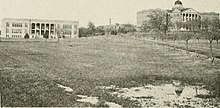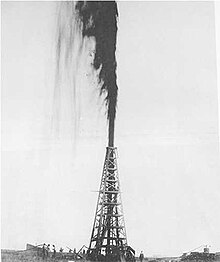Federal Writers' Project – Life Histories/2021/Spring/105i/Section 22/Ed Rutledge
Ed Rutledge | |
|---|---|
| Born | Fort Worth, Texas |
| Cause of death | Unknown |
| Nationality | American |
| Occupation |
|
| Children | 1 |
Overview
[edit | edit source]Ed Rutledge was a white American knitter and car mechanic born on a cotton farm near Fort Worth, Texas. He was interviewed for the Federal Writer's Project on December 18, 1938 in Burlington, North Carolina.[1]
Biography
[edit | edit source]
Early Life
[edit | edit source]At the age of ten, Rutledge and his family visited his uncle, a cotton broker, in Vera Cruz, Mexico. This was Rutledge’s first international experience. According to his interview with the Federal Writer's Project, he was "astonished" by Mexican culture, and the fact that his uncle and aunt both could speak Spanish.[2]
His mother was raised in West Texas near the New Mexico border. When she became sick in 1924, she took the young Rutledge to her brother’s home, which was on the same ranch she grew up on. She would only live a few months more and died on March 21st, 1924. Rutledge was approximately 12 years old. Rutledge's father, a quiet man who loved to read, was impacted by this. In his interview with the Federal Writer's Project, Rutledge said that his mother's death took a heavy toll on his father who fell ill in 1927.[3] Rutledge wanted to drop out of school to help manage the family property, but his father refused. After he finished high school in 1928, Rutledge stayed at home to care for his father, who eventually died in February of 1929. The causes of his parents' deaths are unknown.
Search for Employment
[edit | edit source]After the death of his father, Rutledge got a job as a waiter in a local Fort Worth, Texas restaurant that paid $6 a week, and sold his father’s land to pay off his debts. However, in January 1930, just months after Black Tuesday and the start of the Great Depression, the restaurant in which he worked shut down. By Spring 1930, Rutledge had just $30 to his name.
Rutledge started traveling with another young, unemployed man named Sam Haines in April of 1930 to search for a job. Beginning their search in Texas, they made it all the way to Monroe, Louisiana, where Haines’ Ford car finally broke down. After this, they took a train to New Orleans, Louisiana, and then made their way to Birmingham, Alabama, where Haines found a job. At this point, the pair had just 60 cents between the two of them.
While Haines had a job and a residence, Rutledge was still unemployed. Thus, he decided to leave Haines in search of his own job. He made his way to Georgia, South Carolina, and then Greensboro, North Carolina, where he found a job at a car servicing station on July 3rd, 1930.

At the service station in Greensboro, Rutledge began washing cars and eventually became a grease monkey (car mechanic). In this job he earned $12, and then $14, a week. In his interview, Rutledge says that although he didn’t enjoy the work, he thought it better than being unemployed and on the road. He spent three dollars a week to survive and saved $11 a week, so by September 1930, he had $80 to his name.
Eventually, Rutledge found a new job as a knitter in Burlington, North Carolina, which paid $40 a week. At this job, he met his wife. Before their daughter was born, they rented property in the countryside and built a house on it. Rutledge would only have a short commute of five minutes to get to his knitting job each day.
The place and date of Rutledge's death is unknown.
Social Issues
[edit | edit source]Texas Oil Market During the Great Depression
[edit | edit source]
The discovery of oil at Spindletop Hill, just south of Beaumont, Texas, in 1901 signaled new beginnings for Texas’ economy. The cornerstone of the state’s economy shifted from agriculture to petroleum.[4] This brought previously unseen levels of economic prosperity to the state and fueled the notion that Texas would be resistant to the effects of the Great Depression, which began in 1929.[5] In 1930, the East Texas Oil Field was discovered near Kilgore, Texas. Thought initially to be a beneficial development for the state’s economy, it severely impacted the oil market in Texas and the broader United States. The discovery led to extremely high amounts of production, but the Great Depression had caused a slump in demand. This resulted in a crash in oil prices.[6]
To respond to the unstable production levels in East Texas, the Governor Ross Sterling called a special session of the legislature in July of 1931 with the intent of creating legislation that would allow the Texas Railroad Commission limit production to meet market demand, thereby increasing prices and bringing stability to Texas’ oil economy. Due to a federal court decision deeming the proration of oil production illegal, this legislation was not passed. Instead, on August 17, 1931, Governor Sterling imposed martial law in the counties that made up the East Texas Oil Field and controlled oil production using the Texas National Guard and the Texas Rangers.[7]
By the 1940s, however, the Texas Railroad Commission gained regulatory control of the Texas oil market. This coincided with the onset of World War II, during which Texas was a crucial supplier of petroleum to the Allied forces.[8] By the end of the war, the Texas oil market had recovered, and the state’s economy was booming.[9]
Life Expectancy During the Great Depression
[edit | edit source]During economic downturns throughout history, life expectancy and overall population health have, in fact, increased. This is because decreased economic activity is associated with a decrease in most major causes of death.[10] Such was the case with the Great Depression in the United States. From 1929-1933, the economic recession was correlated with a 6.2-year increase in the overall life expectancy of the U.S. population.[11] Infant mortality rates, and general mortality rates for all age groups under 20, declined during the same period.[12] Additionally, life expectancy for white and nonwhite males and females increased during the Great Depression. Life expectancy grew 8.1 years among nonwhite male Americans and 8.2 years among nonwhite female Americans between 1920 and 1933.[13] This overall trend meant that, in fact, the American population's health became better during the Great Depression.
Notes
[edit | edit source]- ↑ "The Knitter", Federal Writers' Project papers #3709
- ↑ Ibid.
- ↑ Ibid.
- ↑ Ross, Robyn. "There Will Be Oil."
- ↑ Ramos, Mary G. "Oil and Texas: A Cultural History."
- ↑ Garza, Susan Jane. "THE TEXAS ECONOMY DURING THE GREAT DEPRESSION: 1930-1940."
- ↑ Ibid.
- ↑ Ross, Robyn. "How the East Texas Oil Field Changed Kilgore Forever."
- ↑ Labban, Mazen (2010). Space, Oil and Capital.
- ↑ Swanbrow, Diane. "Study: Life and death during the Great Depression."
- ↑ Tapia Granados, José A, and Ana V Diez Roux. “Life and Death during the Great Depression.”
- ↑ Ibid.
- ↑ Ibid.
References
[edit | edit source]- Aoghs.org Editors. “East Texas Oilfield Discovery.” American Oil & Gas Historical Society, October 22, 2012. https://www.aoghs.org/petroleum-pioneers/east-texas-oilfield/.
- Garza, Susan Jane. “THE TEXAS ECONOMY DURING THE GREAT DEPRESSION: 1930-1940.” University of Arizona Campus Repository. University of Arizona, 2018. https://repository.arizona.edu/bitstream/handle/10150/630272/azu_etd_hr_2018_0058_sip1_m.pdf?sequence=1&isAllowed=y.
- Labban, Mazen. Space, Oil and Capital. London: Routledge, 2010.
- Ramos, Mary G. “Oil and Texas: A Cultural History.” Texas Almanac. Texas State Historical Association, November 29, 2017. https://texasalmanac.com/topics/business/oil-and-texas-cultural-history.
- Ross, Robyn. “How The East Texas Oil Field Changed Kilgore Forever.” Texas Highways. Texas Department of Transportation, January 30, 2020. https://texashighways.com/travel/the-east-texas-oil-field-changed-kilgore-forever/.
- Swanbrow, Diane. Study: Life and death during the Great Depression, October 5, 2009. https://ur.umich.edu/0910/Oct05_09/19.php#:~:text=The%20Great%20Depression%20had%20a,Granados%20and%20Ana%20Diez%20Roux.
- Tapia Granados, José A, and Ana V Diez Roux. “Life and Death during the Great Depression.” Proceedings of the National Academy of Sciences of the United States of America, October 13, 2009. https://www.ncbi.nlm.nih.gov/pmc/articles/PMC2765209/
- The Knitter, in the Federal Writers' Project papers #3709, Southern Historical Collection, The Wilson Library, University of North Carolina at Chapel Hill. https://dc.lib.unc.edu/cdm/singleitem/collection/03709/id/757/rec/1